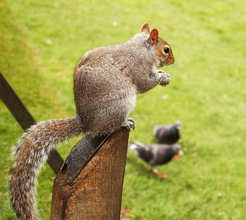Both pet and pest, the North American gray squirrel is the most common native in squirrel in the United States and Canada and the most despised invasive, imported squirrel in much of Europe. Everywhere they range, the communal-minded gray squirrels band together to become the dominant species of rodents in trees, lawns, and attics.
Recognizing Gray Squirrels

The most common gray squirrel is the Eastern gray squirrel, Sciurus carolinensis (you can read a detailed description of them at the Global Invasive Species Database). This is the squirrel that is found in most of the United States and Canada, and that has been introduced to Ireland, the UK, Italy, and South Africa. Most members of this species have gray fur on their backs and white fur on their bellies. In areas where squirrels have few predators, albino “gray” squirrels may predominate, and in the Maritime provinces of Canada, most squirrels in this species have jet black hair on their backs. Some Eastern gray squirrels will also have blond, brown, or reddish tints in their fur.
There are three more species of gray squirrels that have much more limited ranges. The Western gray squirrel, Sciurus griseus, has dark gray to black fur sprinkled with silver hairs in a salt-and-pepper fashion on its back, and a silvery coat on its belly. It lives on the Pacific coasts of the United States and Canada (read more at the ADW).
The Mexican gray squirrel has silvery-gray fur on its back with reddish fur around its ears and on its tail. It has a red underbelly.
The Mexican gray squirrel is common in southern Mexico and Central America, and has been introduced to the Florida Keys. The Arizona gray squirrel, Sciurus arizonensis (read more at the Nature Works), lives at higher elevations in the American state of Arizona and in the neighboring Mexican state of Sonora. It has white fur not just on its belly but also on its legs and sides, providing it with camouflage in the snow. Most of the gray squirrels in the world, however, are Eastern gray squirrels from the eastern half of North America.
What’s Not to Love About Gray Squirrels?
Most North Americans know gray squirrels from watching them frolic in the park. Most Europeans know gray squirrels as the carriers of squirrelpox that have wiped out native red squirrel populations.
Unlike other species of tree squirrels, Eastern gray squirrels cooperate with each other. They share territory and food supplies. They will band together to fight predators, whether it is taunting a snake or throwing nuts down from a tree, pelting a cat or dog. They share nests, so a single gray squirrel may have access to as many as 50 nests to find food or escape other animals. Eastern gray squirrels are also larger than red squirrels that may coexist in their territory.
The larger size of the gray squirrel gives it an advantage over other squirrels in surviving disease. Extra body fat keeps it from starving when it is sick and cannot forage. Gray squirrels get the same diseases as smaller red squirrels, but they generally survive and become carriers, while red squirrels quickly die in isolation.
In much of Europe, gray squirrels are quickly displacing red squirrels. But in much of North America, it is gray squirrels that are a pest to homeowners.
The Kinds of Damage Caused by Gray Squirrels
Gray squirrels are omnivorous. They eat nuts and acorns that other species of squirrels cannot digest. They feed on growing plants, vegetables, fruit, and berries. They even feed on insects and song birds when their diets do not provide enough protein. And because they constantly need to sharpen their teeth, they gnaw away at insulation, side boards, sheet rock, and roofing materials.
Gray squirrels chewing on insulation can cause power and service outages. They may get caught in transformers and short out electrical lines. They can interrupt phone and cable service by severing fine wires. Squirrels may make nests out of the insulation in attics and walls, reducing energy efficiency of a home. And they can devastate gardens and drive off song birds.
Squirrel damage can lead to major repair bills. No matter how angry squirrels can make homeowners, however, it’s usually not efficient (and sometimes is not lawful) to kill gray squirrels.
Read this article to learn How to Get Rid of Squirrels in the Attic.
Effective Pest Control Over Gray Squirrel Infestations
When gray squirrels become so numerous that they are described as infestations rather than as populations, the most effective pest control products for squirrel control usually involve humane methods like an non-harming squirrel repellent or a Havahart trap. Sometimes squirrels invade vegetable beds and fruit orchards in search of water, not food. Simply providing water at the edge of a property may prevent fruit and vegetable damage.
Squirrels will not damage utility connections they cannot reach. A roller system caller the Critter Line Preserver spins squirrels off the lines across which they try to run.
And it isn’t always necessary (or smart) to kill squirrels in an attic. Just install a one-way door that lets squirrels out, saving the bother of dealing with dead squirrels, but does not let them back in. Then repair gaps in eaves or siding with steel so squirrels can never gnaw their way in again.
Squirrels are a lot more fun to watch in the park or in the woods than in your attic or garden. Using the techniques here “how to get rid of squirrels” can help you eliminate squirrel problems safely, effectively, inexpensively, and legally with the right combination of techniques.

Leave a Reply